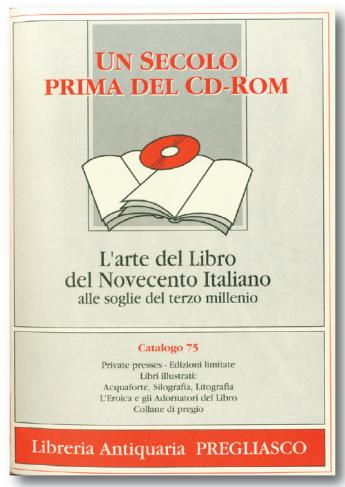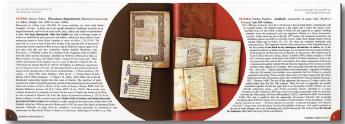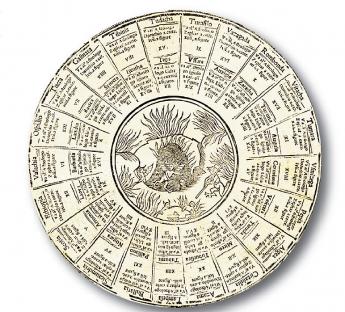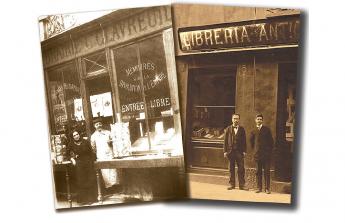Libreria Antiquaria Pregliasco III

By Umberto Pregliasco
Part 3
To choose a good book, look in an inquisitor’s prohibited list.
(John Aikin)
Tradition in Innovation
Although the pedigree of the bookshop drowns into tradition and perks up once more in the early Twentieth century, the changing of generations has added innovation and modernity to the stylistic methods of the profession, in a virtuous equilibrium between the old and the new. Happy testimonials of this marriage were four catalogues and each one of them was singular in its own way. A choice of 100 books was published in 1992, in English only, with an innovative pagination which presented only one book description per page, accompanied by an illustration. In 1998 Elena Vanossi was responsible for A century before the CD-Rom (Cat. no. 75), original celebration, towards the end of the Twentieth Century, of the Italian ‘900 books printed with the hand operated printing press, and of those characters, printers mainly as a hobby or for fun, who realized, without any precise purpose for profit, few volumes entirely conceived by them, produced and sold, often with difficulties’.
We desired to add an introduction dedicated to each of the publishers, and to provide a title that would underline the great distance, not only in time, between the almost lost craftsmanship of the printing press and the future of reading aided by a digital support, in spite of the fact that at the time, we could not even imagine the arrival of the ebook. A note in the introduction states: “This catalogue, unusual in a certain way, produced after some eighty years of activity of our Bookshop, that by tradition has been addressed more towards antique books, but which has always been very interested in the new cultural and market trends, has been put together mainly in the evenings and on holidays, partly due to the lack of time, partly for a sentimental recognition for the private printers, and above all to Franco Riva, who had printed his ‘Editiones Dominicae’ (Sunday Editions) on his very day without any work related commitment”. This sharing of feelings with Riva and Mardersteig, Tallone and Fogola, Ratta and Scheiwiller, in a certain way represents a challenge with the digital era, with the awareness that the “vegetable memory” of the paper can never be replaced by the “mineral memory” recorded on the silicon of the chips. Since the pleasure of a book, as it is an object, is also capable of appealing the other human senses, besides the mind and the sight: the sense of touch – the binding and the pages – the sense of smell – the smell of leather, of the pages, of ink – the sense of hearing – every paper “singing” or “crackling” with different tones and fragrances.

Exhibitions and Experimental Catalogues
With the changing of the occasion for which the catalogue has been created, also the criteria for page settings and selections can change. One example of this are the publications for our international exhibits, which have a tendency to be created according to the type of visitors anticipated, or that might be a chance to unleash innovative ideas. As a matter of fact, it was for an exhibition in New York that A Singolar Tenzone (2007) was conceived. It was a catalogue that was both a game and a challenge with the friends of Libreria Philobiblon, a lively experiment where on two pages next to each other two books with similar characteristics would be presented “in competition”. The idea came from, funny to say, a novel by Jonathan Swift: The Battle of the Books, published in 1704. Gulliver’s author, in that tale, was imagining a battle between classical volumes, driven by a bee, and the modern contemporary ones driven by a spider, to conquer the highest shelves of the library at Parnasus. Books, and above all antique ones, do not fight: only humans might think of animating them for a battle. These are difficult objects to exhibit, by definitions, that are almost diminished in their being free - “libri e liberi” - to be exhibited; at the fairs the booksellers are available to allow the visitors to leaf through the pages, with extreme care, of these testimonials of the past that have lived through centuries of wars, floods, fires, and that came to us intact.
Fun and game, between the curiosity for books and the will to explore new technologies, were the passwords, in 2008, to produce the DVD Fortune, an interactive and playful “catalogue” that was presenting an extraordinary collection of different manuscripts and printed editions of divination works – from Fanti to Spirito to Marcolini – consulted using cards and dices. Thanks to the digital support, this kind of books was no longer used only as an example of magnificent illustrated editions, but it really could be once again be really “played” as the publishers had intended. Starting from the questions asked in the wheel of fortune, reproducing the exact divinatory path presented in the original work, we could get to the point where an answer could be offered for the different questions, such as happiness in life, love, our own spouse’s faithfulness, leaving for a trip... According to the question chosen, you start from one of the Kings, represented as bearded savants, with the attributions of power; then throwing the dices, the results are being compared to the Spheres where their quadrants bear the number combinations, corresponding to the name of a Prophet and, as a consequence, the answer to one’s own question. Such experiment, projected in the booth on a large scale monitor, really attracted the visitors’ curiosity.
"Here, from floor to ceiling in every room, are amassed arrays of old books. They line the walls of the narrow staircases; they surround you, envelop you, a wonderful, warm, scented womb. Pluck the books out, and each smells different ..."
"With a little help from our friends"
Libreria Philobiblon. The majority of those projects has been realized thanks also to the cooperation with Libreria Philobiblon, a bookshop that luckily celebrates its first decade of activity in the same year we celebrate our hundredth year! Among the catalogues published by Philobiblon during this passionate and dense period we are pleased to remember here the one devoted to the extraordinary editions printed by Aldus Manutius, the most celebrated Italian typographer of the 16th-century, the one including the most precious editions of the works of the Dominican friar, philosopher, mathematician and astronomer Giordano Bruno, the monograph “Arché-Techné” collecting the milestones of architecture, the one concerning Dante Alighieri, including some of the rarest editions of the Divine Comedy, but also the recently monograph publications offering the earliest known books about soccer, a collection of Hebrew books and a selection of fables.
But probably the most ambitious and astonishing joint-venture that this young and active bookshop, located in Milan and Rome, invited us to project together is Myriobiblon. In fact, by a series of four catalogues, we have in aim to retrace the history of the printing of early Greek books from the appearance of the first Greek founts to the publication of extraordinary volumes, masterpieces of the art of typography. The first volume of Myriobiblon was published in 2010 and includes a rich collection of Greek lexicons and grammars. The second volume, which will be issued in 2011, will propose an incredible florilegium of the most important editions of the major authors of the Greek classical antiquity. In the next years the project will continue with the third volume about liturgical books and the last one including a collection of the rarest editions of Theocritus, all with extraordinary provenances.

“Gentlemen, it’s been an honour playing with you...”
I worked as a book dealer for 30 years, while my father takes pride in his 60 years-long experience; it’s a long time but doubtless a time well spent. During all these years we’ve been honoured meeting so many extraordinary people: bibliophiles, librarians and, above all, colleagues with whom we shared ideas, insights and of course culture. The exchange of views with fellow book dealers from all over the world has been an irreplaceable resource in doing our job, and doing it with the most passionate attitude. Besides the economic incentive, we cannot help but consider the intellectual profile involved in the book dealing as a truly gratifying reward.
The first ILAB Congress I attended with my father Arturo – I was 10 years old at the time – was London 1971. I met there English booksellers such as Bill Fletcher and the young Nicholas Poole-Wilson and the founder of the LILA, Menno Hetzberger. Later I met my father’s colleagues, H.P. Kraus, Bernard Breslauer, Jacques Vellekoop, Mitsuo Nitta, Fernand de Nobèle, François Chamonal, Hans Bagger, Barney Rosenthal, Larry Witten, Anton Gerits and Bernard Clavreuil; and I became good friend of sons of many foreign booksellers. Now they have become leading dealers and with Stéphane, Keith, Rodolphe, Arnoud; as well as with other “children” as Alicia, Detlev and Clemens, or first generations in the trade, but good booksellers and fellows such as Jonathan and Megumi, Richard and Seyla, Benjamin, Timur, Lucia and Fuad Audi, among the others, for 30 years I have been sharing experiences of books, friendship, holidays. Especially with Bernard and Stéphane Clavreuil, Librairie Thomas-Scheler, my father and I had a very close friendship, which brought us to do business and to have fun together for many years. The same kind of relationship sometimes also occurred with a few collectors, who turned out to be charming interlocutors, and not only about books. I cannot help but recall the epistolary relationship between the English bookseller Anthony Hopkins and the American collector Anne Bancroft in the elegant 1987 movie 84 Charing Cross Road, or the more carnal one – but still related to a 17th century book – between the bookseller Johnny Depp and the diabolic Emmanuelle Seigner in Polanski’sThe Ninth Gate, based on the novel by Pérez-Reverte.
" ... One smells not only of dust but of mushrooms; another of autumn woods, or broom flowers in the hot sun, or roasting chestnuts; some have the acrid, damp smell of coal burning, and others smell of honey.”
(Gerald Durrell)
Bibliographical Repertoires, Unlucky Witnesses of Changing Times
In 1975 we published a catalogue totally dedicated to the “science” of the exact description of books, and with a certain pride, it was published in French, to honour the main language of bibliophiles.
Bibliographie (no. 40) was proudly presenting about 200 items that have almost all been sold to American and Japanese libraries. A quite less rich chapter, added to a catalogue published in 2009, on the other hand, has obtained a scarce success, especially in comparison with the enthusiasm raised by its predecessor. This is proof that there has been a radical change in the approach for bibliographical work, revolutionized by the large quantity of information that is available today through the internet. While some times ago, only the persons within the business had the instruments needed to verify the completeness and the rarity of an edition, now even the buyers can ascertain that a description corresponds to the truth. As a consequence, both the interest that has been created among the collectors, and the selling value of the repertoires have substantially been reduced.

The Art. Documentation and Sources
“All art is perfectly useless”: the provoking phrase by Wilde taken from The Picture of Dorian Grey sounds as if it were a sad and prophetic warning, since the art catalogues seem to be doomed to the very same unlucky judgment that the repertoires of bibliographies have undergone. Through time, catalogues dedicated to art monographs, each including about 2000 titles, had obtained a considerable success as far as sales. Belle Arti (Fine Arts) (no. 37) was published in 1973, while no. 46 was published following the acquisition, in 1982, of the amazing library of the critic Marziano Bernardi. For the first time, books that were out of print were offered on the market, even recent ones, that as of today can easily be found using search engines, or which have lost their documental importance, since the information and the reproduction of the works are available on the web. A different story is the topic of ancient sources for art history; catalogue 86 deserved a wide article on the Art Newspaper with the ironic title “Ninety years, on paper” which celebrated another anniversary of our bookshop: “It is offering a collection of rare antique art critic texts and nonetheless a collection of narrations of travels through Italy for sale. Many sources of fundamental importance for Italian art history are present, such as: Armenini, Baldinucci, Bellori, Borghini, Cellini; from the ‘Picturesque sailing chart’ by Boschini to the ‘Lives of the most excellent painters’ by Giorgio Vasari”. Other samples of many of these titles will be found once again in the recently published catalogue no. 99.
To travel far, there is no better ship a book.
(Emily Dickinson)
Looking for Details. Specialty Topics
In many cases, the acquisition of libraries put together by collectors through the years has allowed us to publish complete catalogues on various specific themes that were curious and quite often unusual; so Genealogy and Heraldry were created (no. 27, 1970), along whit Celebrations and Shows (no. 82, 2000), and Autographed letters and manuscripts (no. 67, 1993), that was announced by the Art Newspaper of that period: “the letters are carefully described from an historical, biographical, philological and bibliographical point of view, with a partial description of the text, “an enormous job, difficult to imagine” states Arturo Pregliasco, who coordinated the research of three writers. In the catalogue are presented a document written by the humanist Pontano, a long letter by Paolo Giovio and one by Napoleon. The presence of artists is huge: Raffaello Sanzio, Giulio Romano, Sebastiano del Piombo, A. Sangallo, Domenico e Carlo Fontana, C. Maderno, Borromini, Berrettini and Bernini. Among the writers we have presented: F. Guicciardini, Foscolo and Manzoni, up to Verga and Pirandello”.
A particular one was Figurati del Settecento Veneziano e 100 rare edizioni bodoniane illustrated books of the Venetian 1800 and one hundred rare editions by Bodoni (no. 48, 1983), gathering two different niche themes, it was the first catalogue that was young Umberto’s sole responsibility. Another huge monographic work was the Idea del Teatro (no. 91, 2005), with a selfironic subtitle with Mozart’s influence “The Catalogue is this…”; it presented over 550 titles among Tragedies, Comedies, Melodramas, Theatre, Parties, Mimics, Critics, Chronicles, Scenography and Theatrical architecture. Our friend Alberto Basso, a musical critic, wrote the introduction: “Surprising is one of the magical virtues of theatrical action. Also a catalogue of theatrical actions and speeches can be a surprising fact ... Field of artefacts and extravagances, of illusions and spells, but also of conventions, allowing to recognize the shape of thought, the theatre has the task to make the impossible real and to potentiate the desire within us to know, deepen and represent our passions”.
Real books should be the offspring not of daylight and casual talk, but of darkness and silence.
(Marcel Proust)

At last catalogue no. 85, One hundred books on Fencing, made more precious by the introduction by Antonio Spallino, gold-medal at Melbourne Olympics and exceptional bibliophile: “When you happen to go through the pages of a treaty; when you feel the charm of the conversation in a language that speaks to you of the grace, of the posture, of the ability in the act, of the conceptions in starting the attack and in ordering the defence; then I feel that any distance between the fencer and the reader is eliminated and you wonder in a field of extraordinary humanity. Going through it, at times, you can sample lessons in costume, samples of languages, pleasure to the eyes, emotions to the touch ... The extraordinary, almost complete collection, as far as the Italian treaties, presented in this catalogue – of unique importance, as far as the works of art, and of exceptional informational value, as far as the book description – offers the bibliophile a maybe unpublished view over a charming and fascinating world. Just as it is appropriate for the Pregliasco tradition”.
To be continued ...
Part 3 of "Living With - And From - Books: A Century of Manuscripts and Early Printed Books of Literature, Fine Arts, Science and First Editions", published by Umberto Pregliasco on the occasion of the 100th anniversary of the Libreria Antiquaria Pregliasco. The text is presented here by permission of the author.
>>> Libreria Antiquaria Pregliasco
>>> Celebrating one hundred years of Libreria Pregliasco - watch the video on Vimeo
